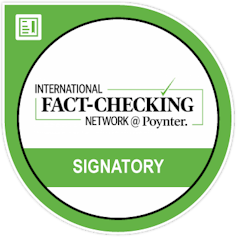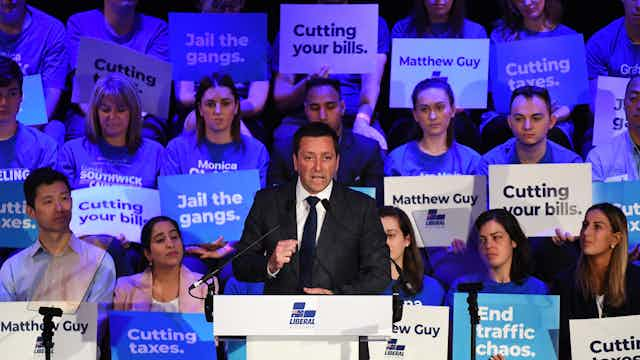But sadly, under Daniel Andrews Victoria has won the unenviable title as the state with the country’s highest rate of crime.
– Leader of the Victorian Liberal Party Matthew Guy, speaking at the party’s election campaign launch, 28 October, 2018
The Victorian Liberal Party has promised to take a tough stance on crime if elected on November 24, with proposals including mandatory minimum sentencing for repeat offenders of serious crimes (including murder, rape, aggravated home invasions, aggravated burglaries and car-jackings) and an overhaul of the bail system.
At the party’s election campaign launch, Victorian Opposition leader Matthew Guy said Labor had presided over a “law and order crisis”, adding that under Premier Daniel Andrews, “Victoria has won the unenviable title as the state with the country’s highest rate of crime”.
Is that right?
Response from Matthew Guy’s office
The Conversation asked a spokesperson for Matthew Guy for sources and comment to support his statement, but did not receive a response before deadline.
Nevertheless, it is possible to check the statement against publicly available data.
Verdict
Leader of the Victorian Liberal Party Matthew Guy said that “under Daniel Andrews, Victoria has won the unenviable title as the state with the country’s highest rate of crime”. The assertion is incorrect.
The Andrews government was elected in November 2014. According to Australian Bureau of Statistics (ABS) Crime Victimisation Survey data, between July 2014 and June 2017 (the latest figures), Victoria did not top the nation in terms of crime rates for any but one of the 11 measured categories of personal and property crime.
Looking at the Crime Victimisation Survey results for three years up to and including 2016-17, Victoria showed the highest rate of sexual assault in two of those years. However, the ABS said the sexual assault data must be used with caution due to the small sample size.
For the other ten crime categories, the Victorian crime rate was lower than at least one other state or territory in each of the three years considered.
ABS Recorded Crime data show that between 2014 and 2017, Victoria did not have the highest rate of murder in the nation, nor did it have the highest rate of criminal offenders proceeded against by police at any time between November 2014 and June 2017.
Comparing crime rates between states and territories
Making comparisons between recorded crime rates in different states and territories is fraught with difficulty, due to the differences in police practices and counting methods across the nation.
The most reliable data set for this task is the Australia Bureau of Statistics (ABS) Crime Victimisation Survey. Published annually since 2008-09, the national survey collects data on people’s experience of violence and household crime.
The survey records both reported and unreported crimes. Given that not all crimes are reported to police, this provides us with a bigger picture.
The questions asked in the ABS Crime Victimisation Survey are the same for all states and territories. The victimisation rates represent the prevalence of selected crimes in Australia, expressed as a percentage of the total relevant population.
Personal crime statistics
This part of the survey records experiences of crime across: physical assault, face-to-face threatened physical assault, non-face-to-face threatened physical assault, sexual assault and robbery.
The Andrews government was sworn in on December 4, 2014, and the latest ABS Crime Victimisation Survey data are for 2016-17.
In the years 2014-15, 2015-16 and 2016-17, Victoria did not have the highest rate in the nation for physical assault, face-to-face threatened physical assault, non-face-to-face threatened physical assault, or robbery.
Victoria did have the highest reported rate for sexual assault in 2015-16, and equal highest in 2014-15. However, the ABS warned that the data for Victoria, Queensland, South Australia, and Western Australia should be treated with caution due to the small sample size, and a relative standard error of 25% to 50%.
In addition, the data for Tasmania, the Northern Territory and the Australian Capital Territory had a relative standard error greater than 50%, and was considered too unreliable for general use.
The most recent Crime Victimisation Survey data are presented below.
Property crimes statistics
The property crime element of the ABS survey covers home break-ins, attempted home break-ins, motor vehicle thefts, thefts from motor vehicles, malicious damage to property and other theft.
At no time in the years 2014-15, 2015-16 or 2016-17 did Victoria have the nation’s highest rate of victimisation on any of these measures.
The chart below shows the latest available data:
Murder and homicide
We can look to a different ABS data set – ABS Recorded Crime - Victims – to assess the murder rates across the states and territories for the calendar years from 2014 to 2017 (the latest year for which data are available).
However, there are missing data points in this record: no data were collected in the Northern Territory in 2016, Tasmania in 2010, 2011, 2013 and 2015, or the Australian Capital Territory in 2010, 2011, 2013, 2015 and 2016.
Even with the missing data points, we can see that Victoria did not have the highest recorded murder rate in any of the years from the election of the Andrews government to 2017.
The terms homicide and murder are sometimes used interchangeably, but in fact they mean different things. Homicide is a broader term that includes some counts of manslaughter, murder-suicides, and other incidents.
The Australian Institute of Criminology publishes data from its National Homicide Monitoring Program. The latest report, published in 2017, shows information between July 2012 and June 2014, before the Andrews government was elected.
But as you can see from the chart below, the Northern Territory had a higher homicide incident rate than Victoria (and all other states and the Australian Capital Territory) every year between 1999-2000 and 2013-14. You can explore an interactive version of the chart here.
The issues with recorded crime data
The ABS publishes “Recorded Crime” data on the number and rate of crime victims (with the latest data reporting on the 2017 calendar year), and offenders formally proceeded against by police (with the latest data reporting on the 2016-17 financial year).
These data sets aren’t ideal for comparing crime rates between states and territories, for a few reasons.
The data come from state and territory police administrative computer systems. Each state has subtly different recording methods and police practices, and this affects the comparability of data.
In addition, people’s willingness to report crime to police can differ across the states and territories. As such, the crime victims data are less reliable for measuring crime rates than the Crime Victimisation Survey.
The ABS introduced rules to guide the recording and counting of criminal incidents for statistical purposes, to enable consistency across the states and territories. But there remains some variability in the interpretation of the rules.
The offender data are considered to be a reliable indication of legal actions. But they’re not a direct indicator of crime rates, due to the issues outlined above. Different jurisdictions also have different crime “clear up rates” (the percentage of a category of crimes that are solved).
The number of people arrested and proceeded against, and the types of crimes they are arrested for, can have as much to do with changes in legislation, police policy and practices in different jurisdictions as the number of criminal incidents committed.
It’s very important to keep those caveats in mind when looking at the data in the following chart.
What’s the picture for Victoria?
The data in the chart below is published by the Victorian Crime Statistics Agency, and relates to crime in Victoria only.
The offences shown were chosen as their recorded incidence is generally considered to reflect their prevalence in the community, and the recorded rates are not overly impacted by law enforcement initiatives.
The recorded rates of drug offences and justice offences, by comparison, can be heavily affected by discretionary police decisions.
– Don Weatherburn, with Jackie Fitzgerald, director, NSW Bureau of Crime Statistics and Research
Blind review
This FactCheck is accurate and based on reliable data. The verdict is correct: Victoria does not have the highest rate of crime.
It it worth observing that the latest federal Report on Government Services (2018) does highlight a significant drop in perceptions of public safety in Victoria. Often the public’s perceptions do not match the reality.
It is also noteworthy that the number and rate of criminal incidents in Victoria have been at higher levels in recent years compared to before the Andrews government came to power. – Terry Goldsworthy

The Conversation’s FactCheck unit was the first fact-checking team in Australia and one of the first worldwide to be accredited by the International Fact-Checking Network, an alliance of fact-checkers hosted at the Poynter Institute in the US. Read more here.
Have you seen a “fact” worth checking? The Conversation’s FactCheck asks academic experts to test claims and see how true they are. We then ask a second academic to review an anonymous copy of the article. You can request a check at checkit@theconversation.edu.au. Please include the statement you would like us to check, the date it was made, and a link if possible.

